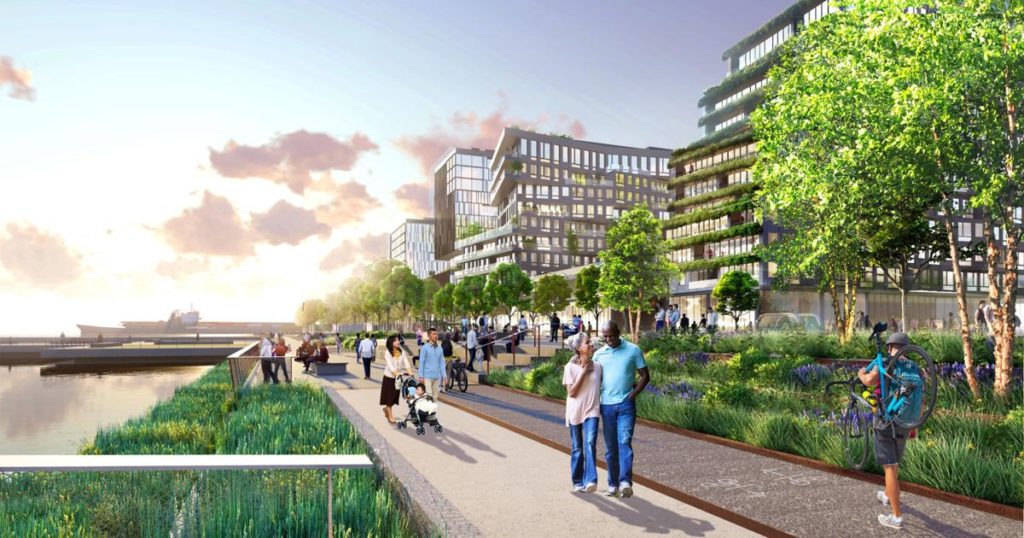Ensemble/Mosaic, a joint venture leading the multi-billion dollar redevelopment of the Navy Yard, said it would invest $1 million in a new foundation to help small, minority- and woman-owned firms to be part of the deal.
It will be called Ensemble-Mosaic Navy Yard Empowerment Foundation. In addition to the $1 million, the joint venture will contribute 2% of its net cash flow to the foundation and ask companies involved in the development to contribute funds or in-kind services, such as paid internships.
“We are going to provide credit enhancement opportunities for small minority contractors. We will be trying to create opportunities to help grow their business, providing paid internships and development programs,” said Leslie Smallwood-Lewis, co-founder of Mosaic Development Partners. “We are going to institute quite a few initiatives to support what is going on throughout all of our projects here.”
The foundation will also donate $10,000 to the NAIOP Drexel University Summer Real Estate program, which is designed to introduce high school students of color to careers in commercial real estate.
Ensemble/Mosaic is a joint venture between Mosaic Development Partners, a Black-owned commercial real estate development firm in Philadelphia, and Ensemble Real Estate Investments and Oxford Property Group.
Smallwood-Lewis made her announcement at the Navy Yard on Tuesday, on the same day Philadelphia Industrial Development Corp. (PIDC) released its 2022 master plan for the 109-acre campus in South Philadelphia. PIDC, a public-private group, manages the Navy Yard on behalf of the city.
The plan calls for 8.9 million square feet of mixed-use development, including about 4,000 apartments, some of which will be reserved for affordable housing, PIDC officials said. It also includes bike paths, bus lanes and 37 acres of green space for recreation.
Kate McNamara, senior vice president of PIDC, said the redevelopment of the Navy yard will bring $6 billion in new investment to the city and up to 12,000 jobs.
“The 2022 Plan for the Philadelphia Navy Yard presents a vision for the best of what a city can be: healthy, resilient, connected, vibrant, and equitable,” said James Corner, founder and CEO of James Corner Field Operations and designer of the master plan. “Leveraging the Navy Yard’s open spaces and extraordinary waterfront, the plan offers a new identity forged around welcoming all; one that balances innovation with history and ecology with urban life.”
McNamara said PIDC chose Ensemble/Mosaic over more than 30 development companies from across the U.S. because of their “incredible” vision for growth for the Navy Yard.
“They also brought a really spectacular commitment to diversity, equity and inclusion that we hadn’t seen before,” McNamara said. “This team has dedicated $1 billion to incorporating diversity and inclusion into all aspects of this plan, starting at the ownership level and working through construction, operations and professional services.”
The Navy Yard had been in operation from 1876 to 1996.
“When we took this property from the Navy in 2000 … thousands of jobs had been lost,” said McNamara, of PIDC. “The campus looked nothing like it does today. It was a lot of vacant buildings and crumbling infrastructure.”
Today, the Navy Yard has 150 companies, with about 15,000 employees among them.
Included in those companies is a thriving life sciences community and the regional headquarters for Ben Franklin Technology Partners, which connects technology firms, entrepreneurs and investors.
In March, Ensemble/Mosaic broke ground on a 137,000-square-foot research and development laboratory at the Navy Yard, which will serve as a business incubator for small gene and cell therapy firms.
The development of the Navy Yard “has been a tremendous success story,” McNamara said.
U.S. Rep. Mary Gay Scanlon’s 5th district represents the Navy Yard area.
“The Navy Yard is really emerging as a center of economic activity for our region,” she said. “We are making the transition from our industrial roots to the economy of the future. It’s going to drive development and growth for years to come.”
